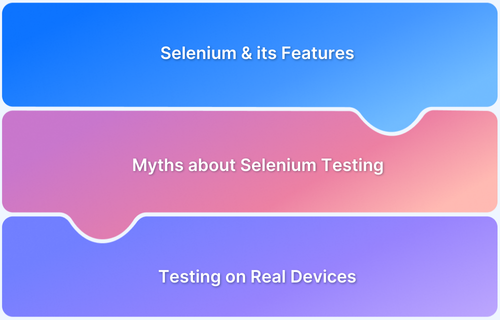Quality Assurance (QA) testing is a crucial part of software development, yet it’s often surrounded by misconceptions that can lead to inefficiencies, poor collaboration, and unrealistic expectations.
Overview
There are several misconceptions about QA testing that can hinder the development process. Here are the top myths and the realities behind them:
Myth 1: QA Testing is Only for Finding Bugs
Reality: QA testing ensures product quality through validation, verification, and user experience, not just bug detection.
Myth 2: The More Test Cases, the Better
Reality: Quality matters more than quantity—effective testing focuses on critical areas rather than trying to cover every possible case.
Myth 3: QA Testing Can Be Done at the End
Reality: Testing should be integrated throughout the development process to identify issues early and improve efficiency.
Myth 4: Testing is Only About Functional Requirements
Reality: Testing also includes non-functional aspects like performance, security, and usability, which are critical for product success.
Myth 5: QA Testing Slows Down Development
Reality: QA testing, when integrated early and continuously, actually accelerates development by identifying and fixing issues early, leading to fewer delays in the long run.
This guide debunks the most common myths about QA testing, clarifying misconceptions and highlighting its true role in ensuring software quality and efficiency.
QA Testing Myths you should know
QA testing plays a vital role in making sure software works as expected and meets user needs. However, there are many myths about QA testing that can lead to misunderstandings about its importance. Clearing up these misconceptions helps everyone appreciate how QA testing ensures better, more reliable software.
Myth #1 – QA Testing is a simple task
This is a massive misconception. A QA engineer worth the name has an immensely difficult task to do. They must possess significant insight into software testing techniques, both manual and automated testing. They must also remain updated with major innovations in the testing landscape.
Additionally, a QA must have an eye for detail as well as great persistence, since it is their responsibility to detect the most minor bugs. The QA would also have to be knowledgeable about innovations, updates or new threats in the digital realm so that they know what bugs or anomalies to test for. Consequently, a QA can’t be good at their job unless they have a solid understanding of not just software testing, but also the development process and business requirements.
Myth #2 – QA Testing does not require a very high proficiency in coding
While coding skills can be helpful, they’re not always necessary for QA testing. With tools like BrowserStack Low Code Automation, you can create test scripts without needing to write a single line of code. These tools simplify the process, allowing testers to design and execute automated tests using visual interfaces and pre-built modules. BrowserStack’s Low Code Automation empowers teams to deliver quality software faster, making it a great choice for testers of all skill levels.
In most cases, testing requires proficiency in code construction. A few common testing cases that require coding would be:
- Writing complex SQL queries to validate data
- Creating test data in instances of ETL testing or data validation
- Converting code written in one DB to another for migration testing
- Write scripts for automated testing in programming languages such as Java, Python, Perl, etc.
A good QA tester must be able to craft a variety of test scrips in order to detect software errors. Similarly, they should be technically proficient enough to explain the nature of bugs or system errors to stakeholders (who may not be technical experts) and developers. This requires them to have a significant understanding of how code works.
Myth #3 – Human QA Testers will become obsolete
With AI and machine learning gaining buzzword status, it is hard not to worry about losing one’s job to a machine. But in the realm of QA testing, it is unreasonable to assume that complete automation will be possible or even desirable.
For example, one still needs human QA testers to write test scripts for automation tools to run on. Similarly, while an automated testing platform using Selenium can detect bugs, it cannot make judgments about a website’s ease of use or the quality of user experience it provides. Manual testers are required for that.
Myth #4 – QA Testing is the Final Step Before Release
As every agile developer will say, no. While it may seem more efficient to test a product after it has been fully developed, software is a tricky business. It is possible for bugs to be introduced in any stage of development. If one waits until the very end to initiate QA testing, then it is very likely that testers will be confronted with a large volume of bugs and anomalies. This is likely to take an exceptionally large amount of time to resolve.
In agile development, QA testing occurs iteratively. Every new feature or even major changes to existing features are tested for bugs at the end of each sprint. Instead of having to debug thousands of issues at one go, this process allows QAs to run tests on every part of an app as it is developed. Simultaneously, the development of new features continues. This means that when the product is finished, it will be relatively stable, bug-free and ready for quick deployment.
Myth #5 – Software Testing is an Unnecessary Expense
Software testing is an essential investment in ensuring product quality, enhancing customer satisfaction, and avoiding costly post-release issues. By detecting and resolving defects early on, testing significantly reduces expenses in the long run.
Myth #6 – Testing can Guarantee a Bug-Free Software
While testing aims to identify and eliminate defects, it cannot guarantee a completely bug-free software. Testing helps mitigate risks and improve software quality, but it should be complemented by other development practices.
Myth #7 – Automation Testing can Replace Manual Testing Entirely
Both automation and manual testing have their place in the software testing process. Automation can efficiently handle repetitive tasks, while manual testing allows for human observation and intuition, especially in user experience and exploratory testing.
Myth #8 – Testing is Solely the Responsibility of the Testing Team
Testing is a collaborative effort involving multiple stakeholders, including developers, business analysts, and users. The entire team shares responsibility for ensuring the quality of the software.
Myth #9 – Testers only Find Bugs; They don’t Contribute to Development
Testers play a crucial role in improving the overall development process. Their feedback and insights help enhance software design, user experience, and overall quality.
Myth #10 – Testing is Time-Consuming and Slows Down the Development Cycle
Although testing requires time and effort, it is an integral part of the development process. Effective test planning, automation, and parallel testing can help streamline the cycle without compromising quality.
Myth #11 – Testers should Test Everything
Comprehensive testing is impractical and inefficient. Testers should focus on high-risk areas and critical functionalities to maximize the effectiveness of their efforts.
Myth #12 – More Test Cases guarantee Better Testing
Test case quality is more important than quantity. Focusing on relevant and effective test cases enhances test coverage and improves the likelihood of finding critical defects.
Myth #13 – Testing is a One-Time Activity
Testing is an iterative process that continues throughout the software development lifecycle. Regular testing, including regression testing, is vital to maintain software quality as changes and updates are introduced.
Myth #14 – Testing is a One-Size-Fits-All Approach
Software testing strategies should be tailored to the specific project, its requirements, and the target audience. Each project may require a unique combination of testing techniques, such as functional testing, performance testing, security testing, or usability testing.
Myth #15 – Testers Should Only Focus on Finding Defects
While defect detection is an important aspect of testing, testers can also contribute to preventive measures. By conducting risk assessments, providing feedback on design and requirements, and participating in code reviews, testers can proactively identify potential issues before they manifest as defects.
Myth #16 – Testing is an Isolated Activity That Occurs at the End of Development
Testing should be integrated throughout the development process, following the principles of agile and DevOps methodologies. This approach allows for early feedback, faster iterations, and the ability to address issues promptly.
Myth #17 – Testers Don’t Need Technical Skills; They Just Execute Test Cases
Testers with technical skills have a distinct advantage. Understanding programming languages, databases, and test automation tools enables testers to collaborate more effectively with developers, automate repetitive tasks, and contribute to the overall software quality.
Myth #18 – QA Testing Slows Down Development
On the contrary, QA testing speeds up development in the long run. By identifying bugs early, QA testing prevents costly fixes later in the process. Regular testing reduces rework, enhances code quality, and accelerates overall delivery timelines.
Why use BrowserStack Tools for Testing?
BrowserStack offers a comprehensive suite of testing tools designed to enhance the quality and speed of web and mobile application testing:
- Live – Provides real-time, manual testing on real browsers and devices, ensuring seamless performance across various platforms and environments.
- Automate – Enables automated cross-browser testing with popular frameworks like Selenium, Appium, and Cypress, accelerating test execution and improving efficiency.
- Percy – Delivers visual testing and UI review capabilities, comparing snapshots against baselines to detect visual inconsistencies and ensure UI integrity.
- App Live – Facilitates manual testing of mobile applications on real devices, ensuring compatibility across different Android and iOS versions and screen sizes.
- App Automate – Automates mobile app testing on real devices, allowing for comprehensive testing across multiple device types and OS versions.
- Interactive Screenshots – Captures and compares screenshots across devices and browsers, helping to quickly identify layout or rendering issues.
Conclusion
Debunking common QA testing myths is crucial for fostering a deeper understanding of the testing process and its importance in software development. Testing is not just about finding bugs; it’s about ensuring software reliability, improving user experience, and delivering high-quality products.
Misconceptions such as testing being the final step, requiring high proficiency in coding, or slowing down development can hinder teams from adopting efficient and effective practices. Emphasizing the collaborative, iterative, and strategic nature of QA testing helps highlight its value throughout the software lifecycle.
By embracing testing as a continuous, integral part of development, teams can ensure they build better software, faster, and with fewer risks.







